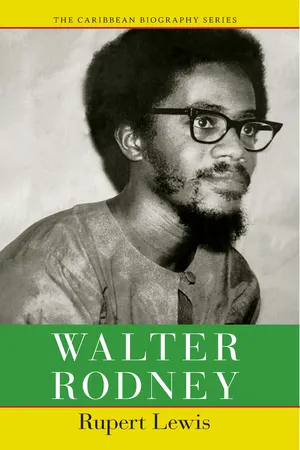Walter Rodney
About this book
Walter Rodney was an exceptional scholar-activist who not only interpreted the consequences of centuries of transatlantic slavery, colonialism and neocolonialism but also engaged in the struggles to change their racial, social and economic legacies. As these legacies persist into the twenty-first century, his life and writings remain profoundly relevant.
He contributed to a distinctive intellectual blend of Black Power and Marxism, that had mass support in the movements of the 1960s and 1970s in the Caribbean and Africa. He had a capacity for listening to people which drew Rastafari youth activists and others to his “groundings”. When the Jamaican government banned him from returning to work at the University of the West Indies in October 1968, there was a mass upheaval, and these demonstrations stimulated the Black Power and socialist movements throughout the Caribbean. His most productive years were at the University of Dar es Salaam in Tanzania, where he taught development studies and wrote his seminal work, How Europe Underdeveloped Africa. A profound scholar of the history of the working people of his native Guyana, he embraced the democratic struggles of Africans and Indians. His radical activism and mass appeal as a leader of the Working People’s Alliance in Guyana led President Forbes Burnham to have him assassinated.
Frequently asked questions
- Essential is ideal for learners and professionals who enjoy exploring a wide range of subjects. Access the Essential Library with 800,000+ trusted titles and best-sellers across business, personal growth, and the humanities. Includes unlimited reading time and Standard Read Aloud voice.
- Complete: Perfect for advanced learners and researchers needing full, unrestricted access. Unlock 1.4M+ books across hundreds of subjects, including academic and specialized titles. The Complete Plan also includes advanced features like Premium Read Aloud and Research Assistant.
Please note we cannot support devices running on iOS 13 and Android 7 or earlier. Learn more about using the app.
Information
Table of contents
- Contents
- INTRODUCTION
- One
- Two
- Three
- Four
- Bibliography
- Acknowledgements
- notes
